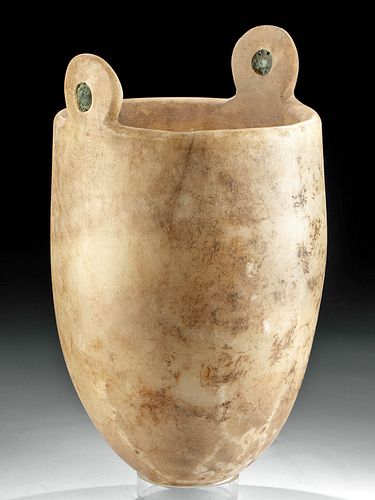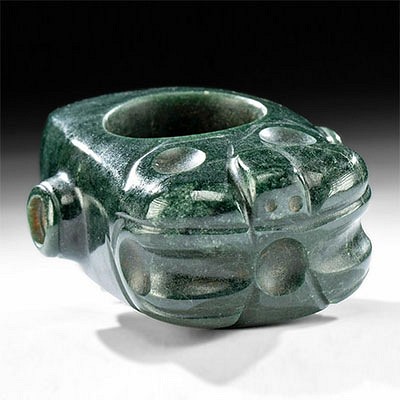Published / Rare Egyptian Alabaster Situla
Lot 3a
About Seller
Artemis Fine Arts
686 S Taylor Ave, Ste 106
Louisville, CO 80027
United States
Selling antiquities, ancient and ethnographic art online since 1993, Artemis Gallery specializes in Classical Antiquities (Egyptian, Greek, Roman, Near Eastern), Asian, Pre-Columbian, African / Tribal / Oceanographic art. Our extensive inventory includes pottery, stone, metal, wood, glass and textil...Read more
Categories
Estimate:
$3,500 - $5,000
Absentee vs Live bid
Two ways to bid:
- Leave a max absentee bid and the platform will bid on your behalf up to your maximum bid during the live auction.
- Bid live during the auction and your bids will be submitted real-time to the auctioneer.
Bid Increments
| Price | Bid Increment |
|---|---|
| $0 | $25 |
| $300 | $50 |
| $1,000 | $100 |
| $2,000 | $250 |
| $5,000 | $500 |
| $10,000 | $1,000 |
| $20,000 | $2,500 |
| $50,000 | $5,000 |
| $100,000 | $10,000 |
| $200,000 | $20,000 |
About Auction
By Artemis Fine Arts
Sep 10, 2020
Set Reminder
2020-09-10 10:00:00
2020-09-10 10:00:00
America/New_York
Bidsquare
Bidsquare : Antiquities | Asian | Ethnographic Art
https://www.bidsquare.com/auctions/artemis-gallery/antiquities-asian-ethnographic-art-5546
Featuring classical antiquities, ancient and ethnographic art from cultures encompassing the globe. Egyptian, Greek, Roman, Etruscan, Near Eastern, Asian, Pre-Columbian, Native American, African / Tribal, Oceanic, Spanish Colonial, Russian, Fossils, Fine Art, more! Artemis Fine Arts info@artemisgallery.com
Featuring classical antiquities, ancient and ethnographic art from cultures encompassing the globe. Egyptian, Greek, Roman, Etruscan, Near Eastern, Asian, Pre-Columbian, Native American, African / Tribal, Oceanic, Spanish Colonial, Russian, Fossils, Fine Art, more! Artemis Fine Arts info@artemisgallery.com
- Lot Description
Ancient Egypt, Third Intermediate Period, 21st to 25th Dynasty, ca. 1070 to 664 BCE. An incredibly rare example of a sizable situla exhibiting a broad form, hand-carved from honey-yellow alabaster with subtle inclusions of light grey and dark beige. The conical situla exhibits a rounded base, a tall body with a thick rim, a deep, drilled-out basin, and a pair of discoid ears with central perforations bearing two bronze terminal caps from an original bronze handle or suspension mechanism. Situlae in ancient Egypt were typically formed from either bronze or hardwood and featured raised decorative motifs of animals or specific deities. The rarity of this vessel stems from its prodigious size as well as the artisan sculpting it from stone rather than choosing an easier material or a less time-consuming method. Lucite display stand for photography purposes only. Size: 6.375" W x 11.4" H (16.2 cm x 29 cm)
Published: Eisenberg, Jerome. "Art of the Ancient World, Vol. XXV - 2014." Royal-Athena Galleries, New York, 2014, p. 86, fig. 194.
Provenance: ex-Royal-Athena Galleries, New York, USA, acquired in the 2000s, reference #BPPE14; ex-Terence Eva collection, London, England, UK, formed between 1970 and 1980
All items legal to buy/sell under U.S. Statute covering cultural patrimony Code 2600, CHAPTER 14, and are guaranteed to be as described or your money back.
A Certificate of Authenticity will accompany all winning bids.
We ship worldwide and handle all shipping in-house for your convenience.
#153156One half of vessel professionally repaired from multiple large pieces, with nearly invisible resurfacing along break lines that is unobtrusive to the overall presentation. Abrasions and nicks to base, body, ears, and bronze remains, and light encrustations to vessel and bronze components. Light earthen deposits, smooth surface textures, and root marks throughout. Nice patina to bronze remains within ears.Condition
- Shipping Info
-
All shipping is handled in-house for your convenience. Your invoice from Artemis Gallery will include shipping calculation instructions. If in doubt, please inquire BEFORE bidding for estimated shipping costs for individual items.
-
- Buyer's Premium



 EUR
EUR CAD
CAD AUD
AUD GBP
GBP MXN
MXN HKD
HKD CNY
CNY MYR
MYR SEK
SEK SGD
SGD CHF
CHF THB
THB
















